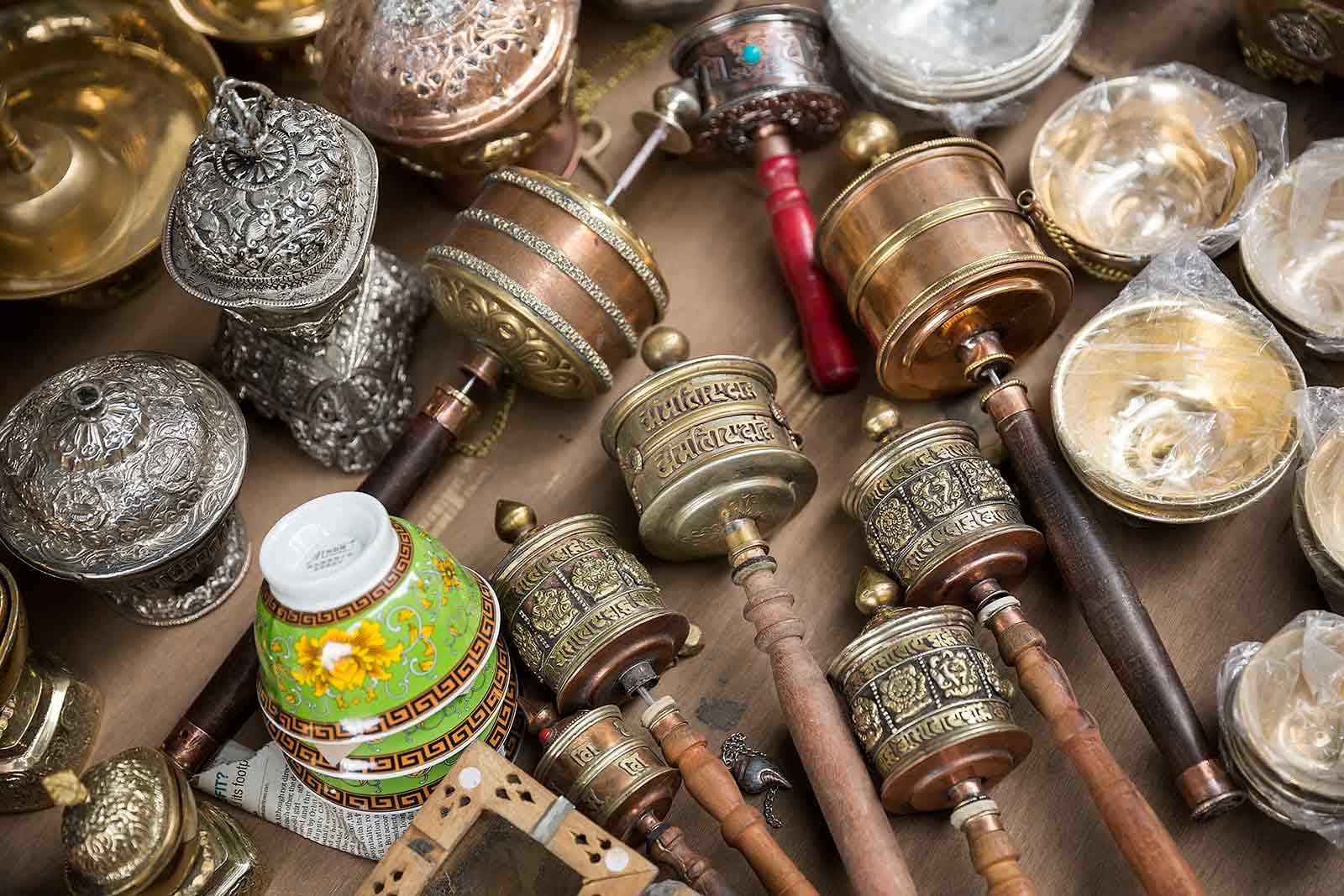New Delhi - Paro - Trashigang - Mongar - Lhuntse - Bumthang -Thimpu - Paro - New Delhi
Bhutan : Textile Trails
For the Bhutanese, textiles are far more than fabric — they are a living expression of identity, heritage, and spiritual philosophy. Each piece is a unique, handcrafted creation, woven with centuries-old techniques that reflect a deep commitment to tradition, sustainability, and artistic integrity. The vibrant patterns and intricate designs of Bhutan’s national dress and ceremonial wear embody the soul of the nation, echoing its rich cultural depth. Isolated for generations from the outside world, the Kingdom of Bhutan has consciously chosen to measure progress not by GDP, but through its world-renowned philosophy of Gross National Happiness. By limiting mass tourism, Bhutan has preserved its ancient monasteries, unspoiled landscapes, and profound Buddhist way of life. As the world’s last remaining Vajrayana Buddhist kingdom, Bhutan offers a cultural experience like no other — where architecture, textile artistry, and sacred traditions remain untouched by time. Here, travelers don’t just observe — they connect, reflect, and awaken to a deeper understanding of life, beauty, and balance.
Experience the Difference
-
Trusted, Local Travel Experts
-
Flexible, Hassle-Free Bookings
-
Real-Time Itinerary Updates
-
Flexible Cancellation Policies
-
Customized Travel Experiences
-
Exclusive Travel Deals

Pick & Drop

Night Stay

Guide

Visa
Tour Plan
Arrive in Delhi, where you will be met and assisted upon arrival, followed by a transfer to your hotel, The Oberoi Maidens, for your overnight stay. In the afternoon, enjoy a rickshaw ride through the bustling lanes of Old Delhi, followed by a guided visit to the iconic Qutab Minar, one of the city’s most impressive historical landmarks. Overnight at The Oberoi Maidens Hotel.
Begin your Bhutan journey with one of the world’s most breathtaking descents, as your early-morning flight into Paro offers stunning views of the towering Himalayan peaks. Enjoy lunch at either Paro Namjo or a heritage restaurant of your choice, where you’ll get a first taste of authentic Bhutanese cuisine. After lunch, visit the National Museum, home to a fascinating collection of artifacts that provide a rich introduction to Bhutan’s history and culture. A short walk downhill brings you to the impressive Paro Dzong, a classic example of Bhutanese fortress architecture and the site where Bhutanese forces famously defended against Tibetan invasions in the 17th century. From the Dzong, cross the charming Nyamai Zampa, a traditional cantilever bridge, before continuing to the Paro town temple, built in 1525, where you’ll view centuries-old wall paintings. You may also choose to visit a traditional Bhutanese farmhouse for insight into daily rural life. On the way back to Paro town, stop at the sacred Kyichu Lhakhang, one of Bhutan’s oldest temples. Here, you’ll have the opportunity to light 108 butter lamps (optional, chargeable) and immerse yourself in the ancient Buddhist customs still practiced today.
Begin the day with an early morning transfer to Paro Airport for your flight to Yonphulla Airport in Trashigang, a rarely visited region that offers an authentic and off-the-beaten-path Bhutanese experience. Upon arrival, explore the local bazaar, where you’ll find beautifully hand-woven wild silk textiles and finely crafted wooden bowls, made by artisans in the nearby hills. If time permits, pay a visit to a nearby monastery to further immerse yourself in the spiritual essence of the region. Later, arrive at Druk Doetjung, your accommodation for the night. This charming boutique hotel, though modest in size, offers tranquil views over orchards and terraced rice fields—the perfect setting to begin embracing the peace and serenity that defines Bhutan.
Enjoy a scenic drive to Mongar, traveling part of the way along a dramatic switchback mountain road. En route, stop at a lemongrass farm, as the region is known for its high-quality lemongrass products. Another highlight is a visit to the village of Yadi, where you'll observe local women weaving on traditional backstrap looms, showcasing a centuries-old craft. After lunch, take time to explore Mongar Dzong and browse the local bazaar, offering a glimpse into daily life in eastern Bhutan. Overnight stay at Wangchuk Resort or a similar property.
Today, we journey to the remote and picturesque region of Lhuntse, the ancestral home of Bhutan’s Royal Family. The drive offers stunning scenery, with scattered villages and small farms perched high above a dramatic river valley. Lhuntse is especially renowned for its masterful weaving traditions, producing some of the finest textiles in Bhutan. The region is famed for the intricate kushuthara style—an elegant fabric woven with extra-weft patterning, often crafted into exquisite dresses worn during formal and festive occasions. You’ll have the opportunity to witness local women at their looms, showcasing a craft that is both a cultural heritage and a vital source of income, with many pieces sold directly to clients in Thimphu and beyond.
Today’s journey is a long yet breathtaking drive through dramatically shifting landscapes, as we travel from the warm, sub-tropical lowlands into the cool, crisp air of Bhutan’s high alpine region. The route takes us over the spectacular Thrumshingla Pass (12,465 ft)—one of the highest motorable passes in the country—before descending into the peaceful village of Ura. From here, we continue onward to Jakar, the administrative center of the Bumthang district, often referred to as the spiritual heart of Bhutan. This enchanting region is composed of four distinct valleys—Chokor, Tang, Ura, and Chhume—each rich in ancient legends, monasteries, and sacred sites that have shaped the country’s deep spiritual heritage.
This morning, we head north to the serene Tang Valley to visit the historic Ogyencholing Manor, originally a monastery that later became an aristocratic residence. Today, it is partly preserved as a museum by Kunzang Choden, a member of the original family and the first Bhutanese woman to write a novel in English, The Circle of Karma, along with her Swiss husband, Walter Roder. The museum offers a rare glimpse into the daily life of Bhutan’s noble families. Once home to five to seven weavers, Ogyencholing played a vital role in textile production—creating fabrics used for clothing, taxation, and ceremonial gifts. A well-curated exhibit showcases the traditional processes of spinning, dyeing, and weaving. After a traditional farmhouse lunch, where you’ll sample local Bhutanese cuisine, we return to explore the sacred sites of the Choekhor Valley. Highlights include: Kurjey Lhakhang, the final resting place of Bhutan’s first three kings, Jampa Lhakhang, one of 108 temples believed to have been built in 659 AD by a Tibetan king to subdue a demoness, And Tamshing Monastery, the spiritual seat of an incarnation of Pema Lingpa, one of Bhutan’s most revered religious figures. Each site holds a wealth of Buddhist art and relics, making the afternoon an enriching spiritual and cultural experience.
After an early breakfast, we bid farewell to Bumthang and begin our journey toward Punakha, with several enriching stops along the way. Our first stop is Zugney, renowned for its vibrant yathra weaving. These thick woolen textiles, woven with intricate supplementary weft designs, are traditionally crafted into versatile items such as rain capes, blankets, rugs, and more recently, jackets. You may also have the chance to witness the natural dyeing process in action—a colorful and time-honored tradition. We then continue to Trongsa, often referred to as the gateway to Western Bhutan, located at an elevation of approximately 10,000 feet. Set against dramatic mountain scenery, the imposing Trongsa Dzong dominates the landscape from afar. Built in 1644 by Shabdrung Ngawang Namgyal, the unifier of Bhutan, the dzong later became the power base of the Wangchuck dynasty, which ascended to the throne in 1907. Historically, the only road linking eastern and western Bhutan passed directly through the dzong’s courtyard, allowing the Penlop (Governor) to control movement and, if needed, close the gates—effectively dividing the kingdom. We will take time to explore this remarkable fortress and learn about its pivotal role in Bhutanese history.
Perched above the dzong, the Ta Dzong watchtower now houses a fascinating museum dedicated to the Wangchuck dynasty—a perfect place to delve deeper into Bhutan’s royal history while enjoying sweeping views of the surrounding landscape. Notably, the tower’s dungeon once held two British soldiers captive during the Duar War of 1864–65. From here, continue your scenic five-hour drive toward Punakha, pausing in the late afternoon for a gentle walk through lush rice paddies to reach Chimi Lhakhang, the famed fertility temple built by the legendary Drukpa Kunley, also known as “The Divine Madman.” His unorthodox teachings and behavior made him one of Bhutan’s most beloved and eccentric spiritual figures. The next morning begins with a beautiful uphill walk to the Khamsum Yuelley Namgyal Chorten, a striking three-story stupa perched high on a ridge overlooking the Punakha Valley. Commissioned by Queen Mother Ashi Tshering Yangdon Wangchuck, the chorten is a masterpiece of modern Bhutanese craftsmanship, created to foster peace and harmony in the kingdom. Later, visit the majestic Punakha Dzong, also known as the ‘Palace of Great Happiness.’ Once the winter capital, it remains the administrative center of the district and is deeply significant in Bhutan’s history. Strategically located at the confluence of the Pho Chu and Mo Chu rivers, the dzong was built in 1637, and to this day, serves as the coronation site of Bhutan’s monarchs.
This morning, begin your journey to Thimphu, crossing the scenic Dochu La Pass at an elevation of 3,050 meters (over 10,000 feet). On a clear day, the pass offers breathtaking panoramic views of the Eastern Himalayan range, making it one of the most memorable stretches of the journey. Dochu La is also home to the striking ensemble of 108 chortens, commissioned by Queen Ashi Dorje Wangmo, one of the four queens of Bhutan’s fourth king. Nearby stands a beautiful monastery, adding spiritual serenity to the dramatic landscape. Continue onward to the capital city of Thimphu, where there will be time to explore the town’s charming streets or pay a visit to the city’s dzong, a fine example of traditional Bhutanese architecture and governance.
Begin the morning with a visit to Changangkha Lhakhang, one of the oldest temples in the Thimphu Valley, dating back to the 15th century. Perched atop a hill, it offers panoramic views over the town and holds deep spiritual significance for local families. Next, explore Bhutan’s rich textile heritage at the Textile Museum, home to a remarkable collection of traditional costumes and fabrics that showcase the intricate weaving and embroidery techniques unique to different regions. A short walk away, the Textile Academy offers a chance to see students at work, weaving or engaged in textile conservation projects. In the afternoon, head just outside Thimphu to the Choki Traditional Art School, a small but inspiring institution dedicated to preserving Bhutanese artistic traditions. Here, students are trained in woodcarving, thangka painting, clay sculpture, and weaving—keeping ancient skills alive. If time allows, cap the day with a visit to a contemporary weaving studio run by an award-winning designer from Eastern Bhutan, blending modern creativity with age-old craftsmanship.
This morning, depart Thimphu for a scenic 1.5-hour drive to Paro. In the afternoon, explore the majestic Rinpung Dzong, meaning “Fortress of a Heap of Jewels”, constructed in 1646 by Shabdrung Ngawang Namgyal. This impressive structure stands as a testament to Bhutan’s rich architectural and spiritual heritage. Next, visit the National Museum, housed in the Dzong’s former watchtower, which features an eclectic collection of art, cultural artifacts, traditional costumes, weapons, stamps, and even a section devoted to Bhutanese dance, flora, and fauna—offering a vivid portrait of the nation's heritage. Cross the picturesque cantilever bridge below the Dzong and return to Paro town, where you may get a chance to witness a traditional archery competition. As Bhutan’s national sport, archery here is a lively event full of precision, singing, and dancing, offering an entertaining glimpse into local culture. Overnight stay at Paro Eco Lodge or a similar property.
On your final day in Bhutan, embark on a memorable excursion to the legendary Taktsang Monastery, also known as the Tiger’s Nest—an iconic pilgrimage site dramatically perched on a cliffside, 900 meters above the Paro Valley. According to 8th-century legend, Guru Rinpoche flew to this sacred site on the back of a tigress to subdue malevolent spirits, consecrating it as a place of deep spiritual power. You may choose to walk or ride for about 1.5 hours up to the viewpoint tea house, which offers stunning panoramic views of the monastery. Those feeling more adventurous can continue the steeper ascent all the way to the monastery itself for an up-close visit. In the afternoon, explore the serene Kyichu Lhakhang, one of Bhutan’s oldest and most sacred temples, dating back to the 7th century. Alternatively, enjoy a visit to a traditional Bhutanese farmhouse for a glimpse into rural life. Later, stroll through Paro’s local bazaar, where you can pick up a few final souvenirs or simply soak in the ambiance before returning to your hotel for a farewell dinner.
Clients Reviews
